#late devonian extinction
Explore tagged Tumblr posts
Text

TAGHANIC
characters: nyx, melinoë, and reaper!nemesis warnings: none, surprisingly. notes: this was originally a one-word prompt submitted by @cthoniccompanion but i accidentally deleted the ask 😞 the prompt was "ephemeral and/or eternal." summary: the ziggurat opens for the first time to let melinoë in, nyx watches her while nemesis's body and consciousness is occupied.
The mention of an extinction event causes Melinoë to tense up a little. She takes another sip from the teacup. The liquid is special, made with a substance that will allow the chthonic goddess to acclimate to the insides of the Ziggurat safely. It is a reminder that this place is neither the House of Hades nor the Crossroads. It is alive and violent. It hates things that do not belong within it. It hates things that are not of the Emperor’s or the Great Family’s blood. It hates things that are not Nyx or Nemesis. It hates everything that the Emperor hates, it loves everything that the Emperor loves.
It tolerates Melinoë.
--
A Machine-Sister’s clear cybernetic hands carefully tilts the angular teapot to pour a strange, hot liquid into a teacup. Steam tinged with a faint blue glow rises, the liquid providing a source, a point, of heat in the cold, vast room.
Nyx reclines on a klinai and playfully caresses the face of the nymph in her lap, a slender finger tracing the biomechanical structure of her cheeks, following curvature of her jaw. Black and violet darkness veils most of her form, the folds of her peplos and contour of her body outlined by the turquoise glow of the wall of tanks. The nymph and her sisters that surround the Night Incarnate are fixated on the black dicranurus trilobites that swim by. Ancient cousins, they move away from the ones that have gotten too close to the glass with a quickness, an anxiousness.
Her attention turns from her daughter to the space across from her, to the Machine-Sister that presents Melinoë with the tea cup and matching saucer. The machine-woman smiles enigmatically when the chthonic princess thanks her.
For the past hour, Melinoë has dutifully sat on the bench of webbed black resin. The furnature pulled like flesh, manipulated to be part of a seating arrangement of many such benches across from Nyx’s klinai made from that same material, permanently affixed to the floor of the room. She has is not as restless as her elder brother. Several millennia have passed since that time of crisis, the princess has matured into yet retains a youthfulness in her face and form. Her ghostly glow of her missing arm is the only other source of light, aside from the tanks in the walls. The darkness of the Ziggurat dulls the orange-red glow of her fire-lick laurels and feet.
Another nymph jumps up onto Nyx’s lap making the other nymph move aside to create more space, resulting in an irritated hiss. She ignores her sister, instead melding into the presence of the Night Herself, standing upright, seeking attention with a series of clicking sounds the end with a sweet chitter. With a smile, Nyx begins to gently touches her little face, placing a soft kiss on her eyeless forehead.
“I wanted to thank you again for letting me into your and the Emperor’s domain, Lady Nyx.” Melinoë’s voice draws Nyx’s attention away from the nymph, resulting a slightly displeased sound from the little daughter. “I never expected to step foot into this place. Nemesis has told me so much about it.”
“It is Nemesis whom you should thank, O champion mine,” Nyx replies, “Without her, the Emperor nor the Ziggurat would have allowed you inside.”
Melinoë lets out a soft, nervous laugh, flustered that the Night Herself still refers to her by that title. Nyx does not wear her impassive mask within this domain that is her home; her violet painted lips form a soft smile at the young goddess, her starlight eyes not as harsh as they are in the House of Hades.
“It has been a very long time since the crisis, yet you still call me your champion, Lady Nyx,” Melinoë says, “I’m very honored, but…. Much time has passed, and things have changed.”
“It matters not how long it has been since that night you helped me escape.” Nyx hears the questioning of whether Melinoë is still worthy of such a title in the young goddess’s voice, masked under layers of politeness and deference. Hecate has told her about these feelings the chthonic goddess harbors. “The Emperor also thinks of you as my champion. The title is permanent.”
Nyx has always wondered if the permanent flustered glow Melinoë seems to have in her presence is because she sees Nemesis whenever she looks at her. It amuses the Night Incarnate. Whenever she looks at Nemesis, she sees the Emperor. But she remembers that the young goddess has never seen the face of her wife, of Extinction Itself. Melinoë has only ever seen her veiled in black, the Sign of Extinction distorting any opacity that might reveal her face.
It makes sense that she would see only Nyx in Nemesis.
A nymph sitting amongst her elder drone-sisters tries to catch a trilobite, putting her hand up to the glass and snapping her jaws of metallic teeth. It scares the ancient cousin, causing it to swim away quickly. The sudden activity catches the young goddess’s attention.
“If I may ask, Lady Nyx, what are these creatures?” Melinoë turns her head around over her shoulder, looking at the small black trilobites swimming in the walls. “I have never seen anything like them.”
“Dicranurus trilobites,” Nyx says, “They are beings from 390 million years ago.”
Melinoë mismatched eyes widen slightly as she stares at the ones swimming by. Nyx doesn’t tell her that the only surviving xiphosurans are actually much older, not wanting to instill more existential dread and terror into the young chthonic goddess. To think that the humble horseshoe crab, as humans call them, could terrify a goddess of ghosts and nightmares. She always found it interesting that the children of Hades and Persephone had no issues meeting the originator of their kind, her parent Old Khaos, but reminders of their place in the timeline of the Earth is an insight into madness.
It is a reminder that there is an end to their existence. It puts their short lives in context of greater forces, greater beings and entities that have existed long before them and will continue to exist long after this universe ends. It is the fear the other gods feel in Nyx’s presence.
There will always be the Night at the End of Everything.
“I did not know things on the surface could last that long,” Melinoë remarks, acknowledging the ancientness of the little beings that seem untroubled by all the complexities of organic life.
“Alas, this species is extinct. These are the only ones left, gifted to us from the Sleeper. The rest of their kind died out during the Second Extinction Event.” Nyx remembers each one well. The Emperor — Extinction Itself — was growing into her attribution. She remembers being with her beloved in the Black Palace, held close in her many arms and tentacles as she orchestrated each mass extinction event, each time becoming more powerful and more beautiful.
The mention of an extinction event causes Melinoë to tense up a little. She takes another sip from the teacup. The liquid is special, made with a substance that will allow the chthonic goddess to acclimate to the insides of the Ziggurat safely. It is a reminder that this place is neither the House of Hades nor the Crossroads. It is alive and violent. It hates things that do not belong within it. It hates things that are not of the Emperor’s or the Great Family’s blood. It hates things that are not Nyx or Nemesis. It hates everything that the Emperor hates, it loves everything that the Emperor loves.
It tolerates Melinoë.
“In the grand narrative of the universe, you and your family are very young,” the Night says, “The Emperor and I remember when neither the Sun or the Earth existed, when this system was without form and only void.”
She knows that her statement does little to ease the discomfort the young goddess must feel, but it is one that must be said. Within her blood is that from those on the mountaintop, those that shun the oldest entities beneath the earth, those that remain oblivious to what exists beyond their realm of ambrosia and family bickering. Melinoë is far from being like her relatives on the mountaintop, but even so, the children of Hades and Persephone ought to remain cognizant of the context of their existence.
Even her own children needed to be reminded of this fact, like the Moirai when she went to them to revive the newborn Zagreus.
“There are few things that are eternal,” the Night continues, “The Great Family, the Emperor, myself, our daughters.” One of the nymphs has fallen asleep in Nyx’s lap, her small hand clutching the goddess’s slender fingers, her little body curled up into a perfect circle. Some of the ancient cousins float up to the glass to observe her. Her violet lips form a small smile, a tenderness. “Love is eternal. Sustaining, nourishing. The love of soulmates. The love of a parent.”
Melinoë casts her gaze away from the primordial goddess, her mismatched eyes drifting back towards the trilobites for a moment.
“I can’t imagine what waiting for eons is like,” the chthonic goddess says, her eyes downcast, lingering on the liquid still in her cup, “Did you ever worry that the Fates would keep the two of your apart?”
���No.” The ethereality of Nyx’s voice has a sharp edge to it, startling the young goddess and causing her to straighten her posture. “I knew that no matter what happened, she would wake up and we would be reunited and we would never be separated again. Her family always looked after me. ”
In this place, Nyx’s words cannot reach the Moirai, she is able to speak freely about the first of the children she bore alone. “They know better than to intervene in things beyond their purview. Not even I would want them to receive the wrath of Nyog’sothep or Nyarlathotep. Or worse, Azathoth or Shai-Hulud.”
While Azathoth ignores all of existence, bathing in the cacophony of sounds by its attendants, its twin spawns are the core of the Great Family, their lines long and extensive, spanning dimensions beyond space and time, spanning entire universes. Shai-Hulud remains on its beloved desert world making spice, making water of life. The old worms are content with ignoring all of existence, content with remaining in their domains. Nyx sees a similar tendency in her wife, for the Emperor is content with never leaving the Ziggurat if she can help it, and her first-shape never leaves the Black Palace.
Yet the old worms dislike it when their youngest sibling is upset. She who is such their precious and beloved centipede, the most worshiped, the most adored. Azathoth prefers that its twin spawn handle situations that arise. If it turns its gaze to the Moirai because their prophesying caused realm harm to its sibling, there would be nothing Nyx could do to assuage its rage. Shai-Hulud is the same, although it is more involved in its sibling’s well-being. When it passes through their domain, its presence is a soothing comfort. It is there alongside Nyx when the Emperor is gripped by weeping, raging madness when one of their daughters is hurt, the two of them there to ease the intensity of her emotions, to kiss her tears away, to calm her, to love her.
Spice lingers in the cold air of the Ziggurat. Particles emerge from the black sand in parts of the building that facilitate the passage of the Grandfather of the Desert. (May His passage cleanse the world.) Nyx has seen some of their daughters sleep near the black sand, their bodies taking on a slight blue tint from their time breathing in the spice. But in this room there is not enough for Melinoë to notice when she breathes, even as it collects at the bottom of her teacup.
The Machine-Sister from before approaches the Night Incarnate, her strange hands hold the folds of her pristine white clothes as she bends down to speak to the goddess, her glowing white oculi averting her gaze in reverence, her head bowed in worship. “Lady Nemesis has finished her diagnostic session. She will be here soon.”
Nyx softly thanks them and notices that the mention of Nemesis pulls Melinoë out of her deep thoughts. The primordial goddess knows that it typically takes a while for Nemesis to regain control of her mind and body after being in the chair for hours, the Old Machines and the Emperor extracting information. The warm glow in the young goddess’s face returns as she drinks the rest of the liquid, leaving nothing behind. Another nymph climbs into Nyx’s laps, finding a space not taken up by her sister, pressing herself as close as she can to her Night-mother’s middle, letting out a series of deep breaths as the goddess gently caresses her face, beckoning her to sleep and dream.
Ancient cousins begin to congregate in the area closest to Nyx. A sound emits from the glowing liquid in the walls, a hum.
“Lady Nyx….” Melinoë can hear the sound, a glaze of blue coating her mismatched eyes. “Are those beings singing—?”
On the far end of the room, the door slides open, mechanisms with the metal and rock hissing like an airlock depressurizing the space. Nemesis crosses the threshold, pulling her heavy body through the door, every sound of servos and panels making a sound as she moves. Melinoë rises from her seat, dwarfed by the sheer size of Nemesis. Nyx sees the light in her eyes, the smile that her teal lips form as her daughter approaches her.
Underneath the pale skin of Nemesis’s face, the last of her skin, her face framed by her long midnight black hair, the Night sees that it bears the dusting of a deep, dark red. Her mechanical biology simulating the glow that Melinoë has whenever she looks upon the primordial goddess. Nemesis’s dark lips form a small smile, an expression so rare that Nyx cherishes every moment she bears witness to it. The happiness of her daughter: the smile she bears, the softness in her golden oculi, the way her black metal hand reaches out for Melinoë. Having just emerged from the diagnostic chair, she
The Night Incarnate shifts her position, carefully moving the nymphs that have chosen her reclining form as the best place to sleep over to the cushions. She rises to her full height, towering over Nemesis and Melinoë. The darkness and spice shifts with her movement, her gems pulsing, the stars that line her hair reacting to the room itself. The ancient cousins move farther down the wall, singing to the sleeping nymphs.
“I understand you have multiple prospects and suitors, Melinoë. Many of them my own children.” The chthonic goddess turns around to look at Nyx, her ghostly hand in Nemesis’s metal one. The Night’s face is impassive, but in her ethereal voice is approval and the joy she feel at seeing her children happy with another soul made just for them. “So long as you continue to love Nemesis and so long as my daughter is happy, this domain will always be open to you.”
“Mother….” Nemesis’s flanged, distorted voice travels across the room. Nyx can hear the gratitude in just that single word and it is enough for her.
With a knowing smile, the Night at the End of Everything waves her hand, wordlessly granting her daughter permission to take Melinoë deeper into the dimension that is home.
#creative impulses#creation: writing#hades game#melinoe hades#nyx hades#nemesis hades#night and extinction#the great family#nemesis x melinoe#it's all about love being the most powerful and eternal force in the universe#i rarely write long conversations so this was a little different from what i normally do#also i got the idea of nyx referring to melinoe as “o champion mine” from ryuuna's art#folks you ever just chill with your gf's mom in an eldritch building that tolerates you?#(taghanic refers to one of the late devonian extinction events that wiped out the dicranurus trilobites)#ever since matty called dicranurus trilobites cousins it's never left my head
9 notes
·
View notes
Text
ALEX HIRSCH IN THE NEW BIGTOP BURGER?!?
#and treytheexplainer hey i know that guy#holy shit ive been looking forward to this episode for months but it somehow still blew up all expectations#a spectacular show of visuals and music. i am not exaggerating at all bigtop burger: up is a goddamn masterpiece#of course a throwaway line from season 1 about cats was actually a major foreshadow about steves character#of course theres a planet of clowns that has existed for billions of years and treats cats as a borderline religious experience#of course alex hirsch plays fucking munkustrap#hey everyone go watch#bigtop burger#wait hang on i just watched it again steve caused the late devonian extinction?? LOL
20 notes
·
View notes
Text
Rewatched the history of the entire world I guess video again to make sure I wasn’t missing something glaringly obvious (I was) in my pov scientific völspa creation myth
I have so many flash cards now
#things I forgot about: quarks and how much potential particles have for mythology#also forgot: that the ozone layer was a late addition relatively speaking#also added: ice ages and also that video just does not talk about all five major extinction events#the video isn’t good for deep knowledge re: not talking about the late Devonian extinction my beloathed but it does speedrun the most#pressing stuff that you might wanna Google further
0 notes
Text
Round 3 - Chondrichthyes - Chimaeriformes




(Sources - 1, 2, 3, 4)
Our last order in Chondrichthyes is Chimaeriformes, commonly known as “Chimaeras”, and informally known as “ghost sharks”, “spookfish”, “rabbitfish”, or “rat fish” (not to be confused with the Actinopterygiian “rattails”.) Historically a much more diverse and abundant group, they now only comprise the living families Callorhinchidae (“plough-nosed chimaeras” or “elephantfish”), Chimaeridae (“short-nosed chimaeras”), and Rhinochimaeridae (“long-nosed chimaeras”).
Chimaeras are soft-bodied, with bulky heads and long, tapered tails. Their pectoral fins are large enough to generate lift at a relaxed forward momentum, similar to a kite, giving the chimaera the appearance of "flying" through the water. Their gill arches are condensed into a pouch-like bundle covered by an operculum with a single gill-opening in front of the pectoral fins, similar in appearance to Actinopterygiians. They lack spiracles. There are two dorsal fins: a large triangular first dorsal fin and a low rectangular or depressed second dorsal fin. For defense, some chimaeras have a venomous spine on the front edge of the dorsal fin. In many species, the bulbous snout is modified into an elongated sensory organ, capable of electroreception to find prey. Instead of many sharp, consistently-replaced teeth, chimaeras have just six large, permanent tooth-plates, which grow continuously throughout their entire life. These tooth-plates are arranged in three pairs, with one pair at the tip of the lower jaws and two pairs along the upper jaws. They together form a protruding, beak-like crushing and grinding mechanism, comparable to the incisor teeth of rodents and lagomorphs. Most living species are native to the deep sea, with some species inhabiting depths exceeding 2,000 m (6,600 ft) deep, though the few exceptions include the shallower-dwelling plough-nosed chimaeras (genus Callorhinchus) (image 2), the Rabbit Fish (Chimaera monstrosa), and the Spotted Ratfish (Hydrolagus colliei) (image 3).
Chimaeras have separate anal and urogenital openings, rather than a single cloaca. Like sharks and rays, male chimaeras utilize claspers for internal fertilization of females, but unlike sharks and rays, also have retractable sexual appendages known as tentacula to assist in mating. The frontal tentaculum, a bulbous rod which extends out of the forehead, is used to clutch the females' pectoral fins during mating. The prepelvic tentacula are serrated hooked plates normally hidden in pouches in front of the pelvic fins, and they anchor the male to the female. Their claspers are fused together by a cartilaginous sheathe before splitting into a pair of flattened lobes at their tip. Females lay their eggs within spindle-shaped, leathery egg cases which they deposit on the sea floor.
As the most ancient of the Chondrichthyans, Chimaeriformes are truly deserving of the moniker “living fossil”. They have been around since the Early Carboniferous, with the earliest known fossil species being Protochimaera, and split off from the sharks and rays during the Devonian. Modern chimaeras are known from the Early Jurassic, but fossil egg cases from the Late Triassic resembling those of rhinochimaerids and callorhinchids indicate that they had a global distribution earlier than this. Modern chimaeras reached their highest ecological diversity during the Middle Cretaceous. Recent studies indicate that chimaeras were likely a shallow-water group for most of their existence, and only fled to deeper waters in the aftermath of the K-Pg extinction event, adapting to the deep sea to survive.

Propaganda under the cut:
Some chimaera venom can cause pain, necrosis, hallucinations, and localized paralysis in humans. It is not deadly to humans, but has been known to kill Harbor Seals that injested Spotted Ratfish (Hydrolagus colliei).
Spotted Ratfish (Hydrolagus colliei) have large, emerald green eyes, which are able to reflect light, similar to the eyes of a cat.
Chimaera teeth are unique among vertebrates, due to their mode of mineralization. Most of each plate is formed by relatively soft osteodentin, but the active edges are supplemented by a unique hypermineralized tissue called pleromin, rather than enamel. Pleromin is an extremely hard enamel-like tissue, arranged into sheets or beaded rods, but it is deposited by mesenchyme-derived cells similar to those that form bone. In addition, pleromin's hardness is due to the mineral whitlockite, which crystalizes within the teeth as the animal matures.
The Australian Ghostshark (Callorhinchus milii) is very popular with fish-and-chips restaurants in New Zealand and is sold as 'flake' or 'whitefish' in Australia.
The Striped Rabbitfish (Hydrolagus matallanasi) can see in total darkness and sense electromagnetic radiation (outside of the visible spectrum) emitted by other marine creatures due to exposed nerves on the sides of its body.
Some species of chimaerids are known to segregate by sex, with females congregating at greater depths than males.
Despite their deep sea habitat and reclusive nature, some chimaera species are still threatened by bycatch due to deep sea trawling for demersal shrimp and prawns. Even when released, most chimaeras do not survive the process of being quickly pulled up from the pressurized deep sea to shallower water.
#description a bit longer than usual because they’re so unlike all the other members of the class#animal polls#round 3#chondrichthyes
102 notes
·
View notes
Text
After carcinization and anteaterization, let's hear it for whaleification:
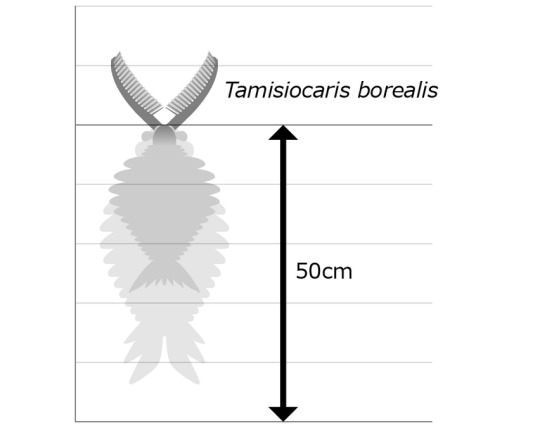
Tamisiocaris borealis (Middle Cambrian, 30-50 cm): a Radiodont, related to Anomalocaris, filter-feeding with its anterior appendages
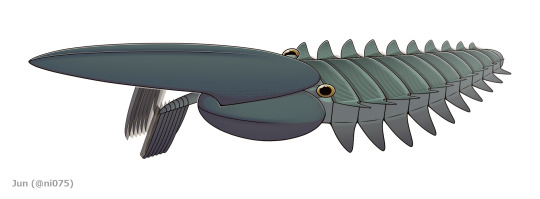
Aegirocassis benmoulai (Early Ordovician, 2 meters): another Radiodont

Titanichthys agassizi (Late Devonian, at least 4 meters): a Placoderm, a group of armored early jawed fish

Shastasaurus sikanniensis (Late Triassic, up to 20 meters): an early Ichthyosaur (possibly suction feeder of soft preys, not quite a filter feeder)

Leedsichthys problematicus (Late Jurassic, 15 meters, possibly more): bony fish of the extinct order Pachycormiformes

Manta birostris (from the Miocene, up to 9 meters): the giant manta ray, a cartilaginous fish

Cetorhinus maximus (from the Miocene, 8-10 meters): the basking shark, another cartilaginous fish

Eubalaena borealis (baleen whales from the Miocene, 13-18 meters): right whale, a mammal
35 notes
·
View notes
Text
March Madness Round 2 Bracket 2
Welcome back to another day of March Madness. Let's see who made it through to compete today! Our first competitor is Jaekelopterus the giant eurypterid! It crushed Arthropleura by 11 points. This arthropod is found in early Devonian rocks in Europe and North America.

It is up against the giant clubmoss relative Lepidodendron which beat out Araucaria by only two points! Lepidodendron fossils have been found across the globe in rocks dating to the Late Carboniferous all the way until the end Permian Extinction event.

#paleontology#fossils#science education#science#geology#march madness#science side of tumblr#vascular plants#arthropods
50 notes
·
View notes
Text
this doesn't matter but Steve can't have been the meteor that wiped out the dinosaurs because he was launched and crashed 365 mil years ago, right? The timeline roughly lines up with when the Tiktaalik existed, and the meteor that killed the dinosaurs landed only 66 mil years ago. Instead, Steve would have caused the late devonian mass extinction event that lines up with the time he was launched from the clown planet.
So what I'm saying
is that a second clown has hit the planet
619 notes
·
View notes
Text
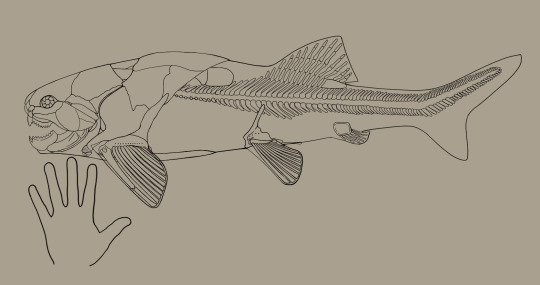
On Earth, Placoderms were a highly diverse group of fish that died out in the Devonian mass extinction due to a global deoxygenation event in the world's oceans caused by massive algae blooms. During the end Devonian extinction on Atterra, it was much the same, except for one key difference. One group of Arthrodire placoderms by Atterra's late Devonian period, between 382-372 mya, had evolved to live in tidal habitats along the coast. Crawling along the shore and rocks, looking for food or into larger pools of water.
These placoderms had adaptations in their pectoral fins similar to Antiarchi placoderms, where the first four cartilaginous rays fused to form a stronger and jointed ray to help push the fish along the ground. The ends of the cartilage rays in the pelvic fins fused to form a joint similar to Epaulette Sharks to help push the fish along the coastal rocks. Preserved tissue impressions in fossils of these placoderms show the presence of brachial tissue in the mouth, similar to Earth's electric eels, allowing the fish to gulp air when out of water.
This adaptation allowed these Arthrodire placoderms to survive the end Devonian deoxygenation event by supplementing oxygen from the air as oxygen levels in the water plummeted. Allowing the placoderms to survive by the skin of their teeth on Atterra, diversify during the carboniferous period, and survive to be found in the fish markets of the modern day.
#art#artwork#creature#creature art#creature design#digital art#drawing#illustration#monster design#monsters#my artwork#my art#doodle#sketch#clip studio paint#clip studio art#clip studio illustration#clip studio pro#sketches#skeleton art#skulls#anatomy#artist#digital 2d#digital illustration#digital drawing#digitalart#fish#fishes#sea creatures
29 notes
·
View notes
Text
One paleoart for each period since the Cryogenian
Thanks to the timeline on my walls that I've been trying to fill in with my art, I have now reached the point where I've done paleoart for every single period of the Phanerozoic, plus the Ediacaran and Cryogenian! That is to say, every period of the last 700 million years. So with that milestone, I thought it'd be fun to go through those periods in order and show off one paleoart of mine for each!
Cryogenian
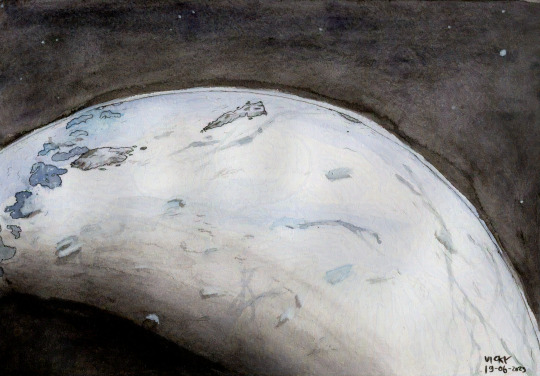
In the Cryogenian, the Earth completely froze over. Twice! Life wasn't much to look at yet, but I enjoyed drawing what our planet might have looked like at the time. The girdle of lakes at the left is the equator, which may have had ice-free patches.
Ediacaran
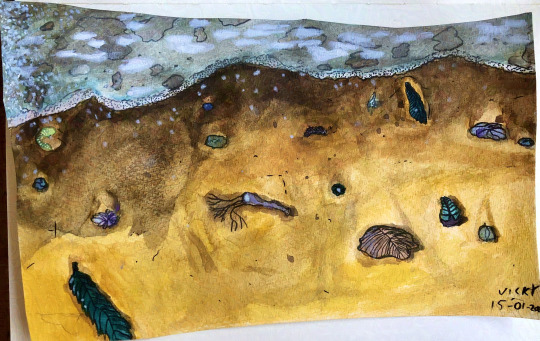
When the ice retreated, animals first began to blossom into their endless forms most beautiful. Ediacaran life was strange and quite unlike the creatures that would come later, but it was nonetheless an incredibly important chapter in life's history. Here we see the Ediacaran weirdos washing up on shore after a storm.
Cambrian

The Cambrian explosion brought much more recognisable creatures. But one thing that's easy to miss is that they were all tiny! All of them? No, Anomalocaris was, with a length of about 40 cm, the dragon of the Cambrian.
Ordovician

Life continued to diversify in the Ordovician, and among this diversity were the cephalopods. They produced the largest animals yet to exist, the orthocones, who hung vertically in the water column and decended upon their prey like a claw game.
Silurian
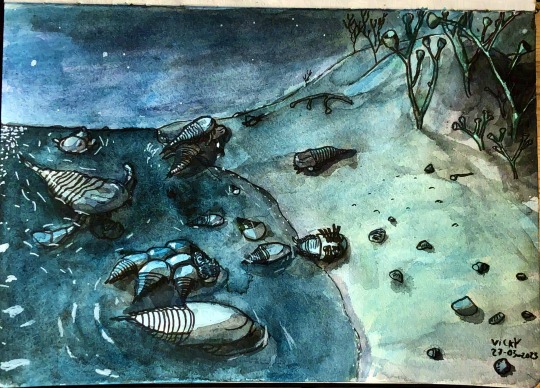
Although fungi and bacteria had already made forays onto the land deep in the past, things began to get busier there in the Silurian. But these horseshoe crabs, and their larger cousins the sea scorpions, have not come to the shore to stay, but to mate and lay eggs. Unfortunately for the horseshoe crabs, they have come to the very same shore.
Devonian
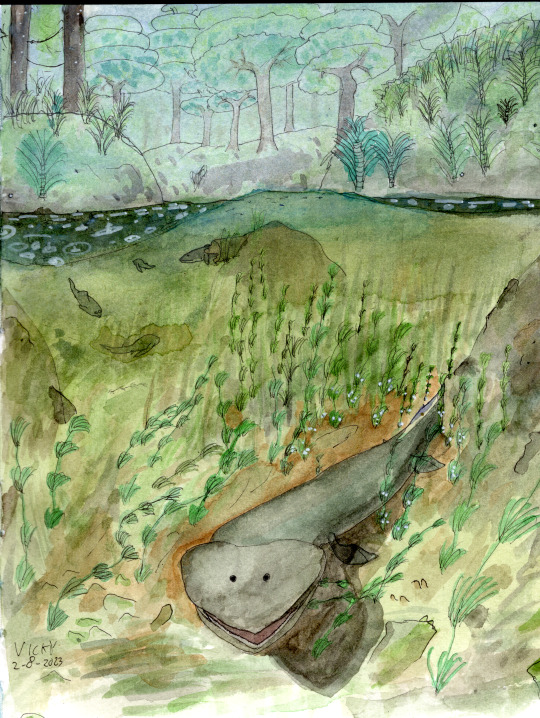
Our own vertebrate ancestors, like Tiktaalik, were pretty late to the party, only taking their first steps on land in the late Devonian. That's no knock against them - there was plenty to do underwater! This Tiktaalik is busy guarding his eggs while his mate is busy hunting, for example. Who has time to step on land?
Carboniferous
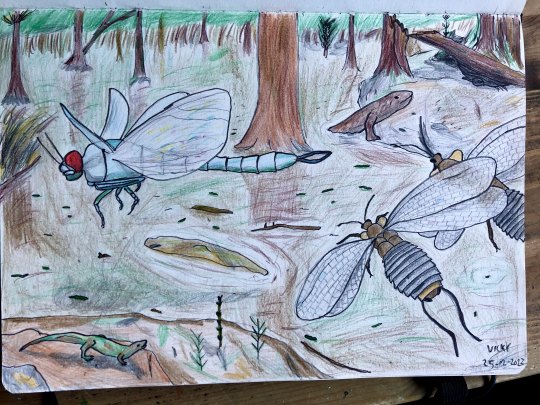
The end of the Carboniferous saw some quite large bugs, like these two Mazothairos chasing off an interloping Meganeura. They're representatives of a pretty interesting group of basal insects called the Palaeodictyoptera, who have a set of weird little extra wings on their thorax.
Permian

Among the many fantastic creatures of the Permian were our own cousins, the synapsids, like these lovey-dovey Moschops. As you can see, this picture and the previous one are done in coloured pencils instead of watercolour, because they're the oldest images I'm including in this post. I only very rarely used watercolours before this year. I think it means I should do some more Permian art, it's such a cool and underexposed period.
Triassic
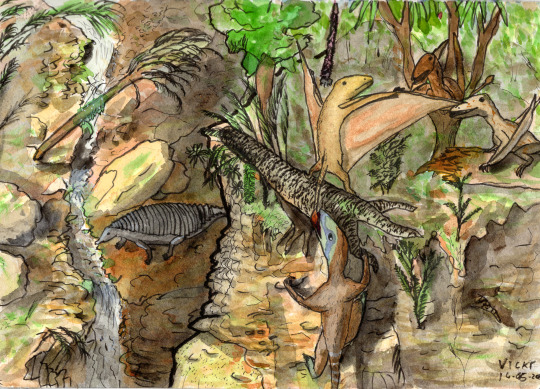
One mass extinction later, the archosaurs are diversifying all over Triassic Pangaea. Here we have the three main groups of them: Paratypothorax, a pseudosuchian in the background; Peteinosaurus, a pterosaur on top of the cliff; and Procompsognathus, a dinosaur climbing the cliff.
Jurassic

I had three different option for Jurassic paleoart to showcase, so I picked the most experimental one. These backlit insects are not butterflies, but kalligrammatids, a group of large-winged neuroptera, some of which even mimicked maniraptoran dinosaurs like this iridescent Caihong with their patterns.
Cretaceous
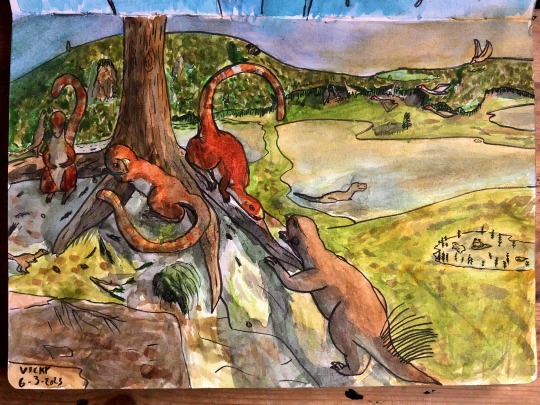
The Cretaceous featured some of life's most gorgeous crescendos of diversity, like the Yixian formation, where a Psitaccosaurus wants to visit the favourite tree of a group of Sinosauropteryxes, who are having none of it. This is still one of my favourite pieces I've ever drawn.
Paleogene
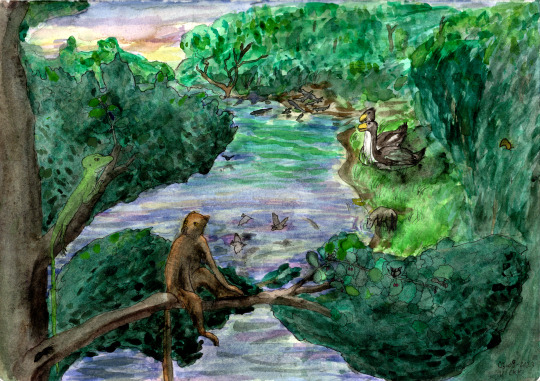
The Paleogene featured some of the highest global temperatures of all time, leading to tropical climates all over the planet, including at this lake in what will one day be Messel, Germany. Darwinius, a close cousin to our own ancestors, is having a staredown with the lizard Geiseltaliellus.
Neogene

The world turned colder and dryer in the Neogene, leading to the spread of large grasslands, like these South American ones. Phorusracos, a large terror bird, has caught a Thoatherium on the edge of the forest they both live in. South America was an isolated continent for the duration of the Neogene, leading to a quite unique fauna.
Quaternary

The Quaternary, our current period, is marked by the cycle of ice ages regularly freezing the northern hemisphere. But even during the ice ages, spring would come to the mammoth steppes, and these steppe mammoths are happy to celebrate its coming with a bath in the river.
#paleoart#my art#palaeoblr#timeline#no i am not gonna tag everything in it#the pictures should all work as links to the individual posts of these pieces#cw: animal death#cw: bugs#cw: parasites#cw: blood
310 notes
·
View notes
Text

A trilobite fossil of a Paladin mucronatus rotundatus from the Four Fathom Limestone Member, Alston Formation in Ireshopeburn, County Durham, England. Carboniferous to Permian aged proetids like Paladin were one of the last trilobites after the Late Devonian Extinction which decimated all other clades. Possibly due to this massive loss in diversity, trilobites would later go extinct during the Permian–Triassic Extinction Event or Great Dying.
#trilobite#fossils#paleontology#palaeontology#paleo#palaeo#paladin#proetidae#carboniferous#paleozoic#prehistoric#science#paleoblr#パラディン#三葉虫#化石#古生物学
92 notes
·
View notes
Text
Happy New Year!
Let's imagine it was the Earth itself that was going into its 2024th year. That is to say, we're compressing the entire history of the Earth into just the past 2023 years. What events would have happened when?
Well, not too much is certain about the first couple decades after our planet formed, until around 50 CE when we were hit by another proto-planet, Theia, and the debris formed the Moon. After a couple years of the planet cooling down again, the oceans formed out of boiling rain. The timing of the origin of life is very uncertain, but there are chemical signs it may very well have happened as early as the second century. Around 200 CE, the gas giants did a big funky orbit-swapping dance, and in the process inflicted the Late Heavy Bombardment on the rest of the solar system, meaning the Earth was suffering a ton of meteorite strikes for the entire third century.
The first indisputable evidence of life is from around 330, and the first stromatolites appear around 470. Those are basically the first fossils, stones created by layer upon layer of oxygen-producing cyanobacteria living and dying on top of one another. But even with oxygen producers evolving, it would take many centuries before oxygen became a major part of the atmosphere: not until the Great Oxygenation Event, which happened during the ninth and tenth centuries. That's also about the time the first complex, eukaryotic cells evolved through a symbiosis between an anaerobic archaean and an oxygen-breathing bacterium. The bacterium became more and more focused on just the oxygen-breathing task inside the larger cell, until its descendants were mitochondria, which as you all know are the powerhouse of the cell. The next seven centuries passed by with only slow, gradual changes, and life continuing to be unicellular and difficult to find in the fossil record.
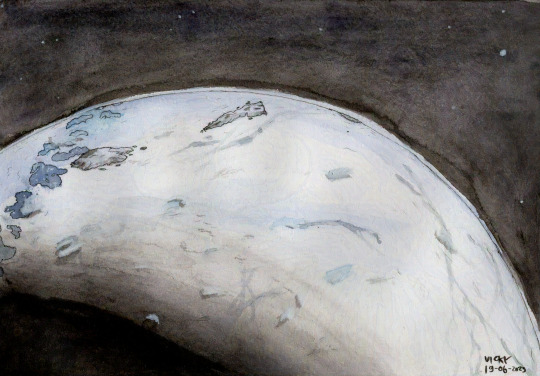
(1735's Snowball Earth, by me)
From 1704 to 1730, the entire planet froze over. After merely two years of thaw, it happened again, this time lasting from 1732 to 1742. But these snowball Earth episodes set the stage for the evolution of animals that began right after. Across the mid-18th century, the bizarre Ediacaran biota, with its strange symmetries, fronds, and fractal-like pattern filled the oceans. In the early 1780s they went extinct, possibly due to a temporary drop in oxygen-levels, only to be replaced by a great variety of quite different creatures in the Cambrian Explosion.
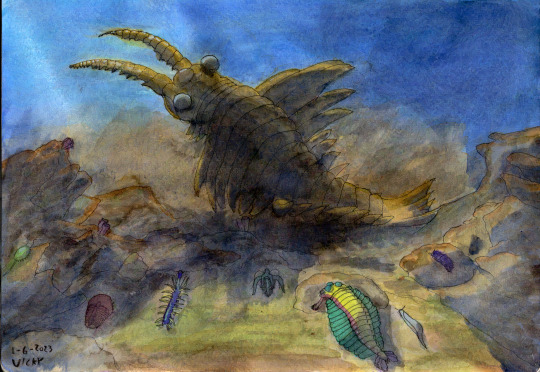
(Class of 1799, by me)
Starting in 1784 and running for a few decades, the Cambrian period saw the origin of most of the modern animal phyla, reaching its most famous form in the Burgess Shale fauna of 1799. During this time, most animals still lived on the sea floor, either attached or crawling, with relatively few actually swimming creatures. Plants started tentatively moving onto land around 1817, and in 1825, the rising of the great Appalachian mountains caused a severe drop in global CO2 and thus temperatures, leading to the Late Ordovician mass extinction.
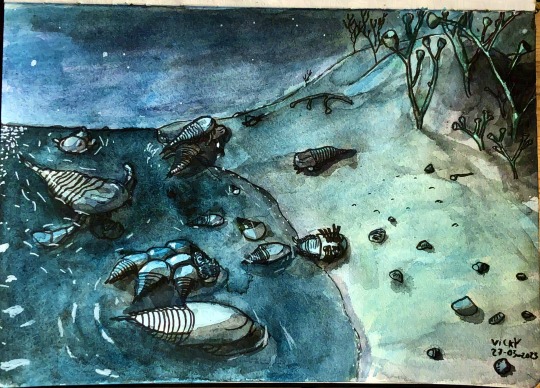
(Horseshoe crabs and sea scorpions on a beach in 1834, by me)
Bony fish first showed up during the 1830s, and around the same time plants were getting serious about inhabiting the land, evolving roots and vascular tissues so they could properly grow there. Millipedes and the ancestors of spiders were the first animals to follow them onto land. Our own fishy ancestors did not take their first step until 1857, by which point the arthropods were well established there and the plants had figured out how to become trees. The Late Devonian extinction, partially caused by the evolution of said trees and partially by the south pole freezing, played out in two pulses over the late 1850s and early 1860s.
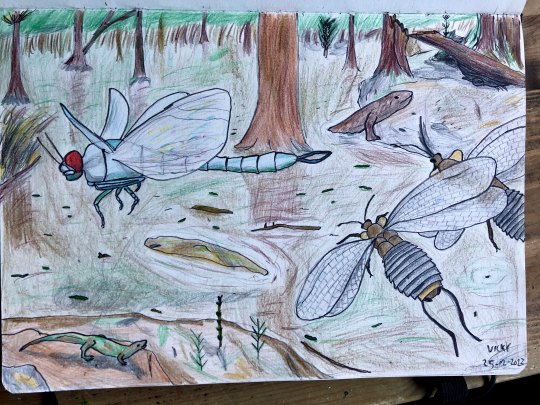
(Swamp prominently featuring Meganeura and Mazothairos in 1889, by me)
Arthropods and vertebrates continued to gain adaptations to life on land. The insects became the first creatures ever to fly in 1878, and the high-oxygen atmosphere of the time would be especially good to them. Around 1884, a group of vertebrates called the amniotes, after the membrane that kept water inside their eggs so they could lay them on land without them drying out, split into two groups: the reptiles and the synapsids (which we mammals descend from). The next few decades would see the synapsids in particular being extremely successful as the supercontinent Pangaea formed. Until 1912, when a massive episode of volcanism caused the worst mass extinction of all time, the Great Dying, scouring the Earth of a huge portion of its life.
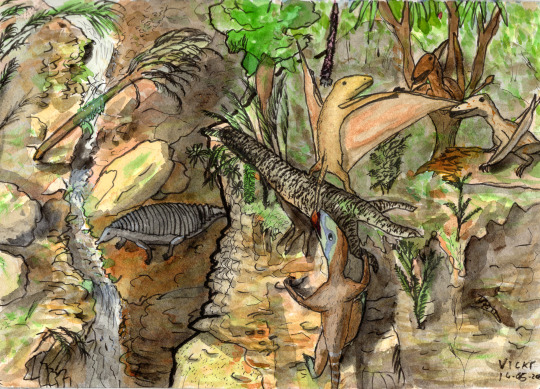
(A 1930 scene featuring the three branches of archosaur: dinosaur, pterosaur, and pseudosuchian, by me)
The 1910s were a period of slow recovery during which strange new forms of animal evolved. Many different, unrelated reptiles, such as the ichtyosaurs and plesiosaurs, went to sea, where they would continue to provide some of the most impressive creatures for most of the 20th century. On land, the dinosaurs first appeared in 1920, though for the next decade or so they'd live in the shadow of their pseudosuchian (crocodile-line) cousins. In 1934, Pangaea began to break up, resulting in another terrible pulse of volcanism that caused a lot of extinctions and left particularly the feathered and furry survivors with a lot of empty niches to fill, allowing the dinosaurs and mammals to diversify greatly. The last common ancestor of all modern mammals lived in the early 1940s, and by 1957 the dinosaurs had figured out flight, with Archaeopteryx usually being considered the first bird. Other dinosaurs took on an incredible variety of sizes, shapes, and forms. Some of the most famous ones include Dilophosaurus (1942), Diplodocus and Stegosaurus (1955), Iguanodon (1969), Velociraptor (1991), and Tyrannosaurus rex (1994).
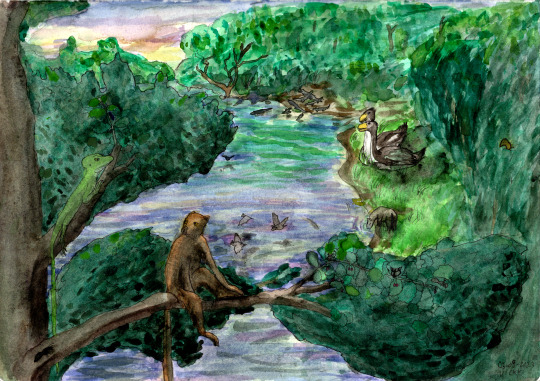
(A tropical lakeside in the year 2000, by me)
In 1995, the world was struck by a meteorite, wiping out many groups, including the marine reptiles, pterosaurs, and ammonites. The surviving mammals and dinosaurs went on to diversify across the next couple of years and had formed thriving new ecosystems in the tropical world of the turn of the millennium. The first known bat lived in 2001, and the whales returned to the oceans next year. Around 2009, the world's climates turned colder and dryer. Antarctica froze over and grasslands spread widely. Our last common ancestor with the chimpanzees and bonobos lived in 2021, and by new year 2023, our ancestors were getting brainier and more proficient with tools. That's also when the north pole froze and the Quaternary ice age cycle began. The first known members of Homo sapiens lived on 10 November 2023. The latest ice age started on 14 December, and ended at 2 AM on 30 December. The great pyramid of Giza was built at 6 AM on 31 December and On The Origin Of Species was published at 23:22 PM.
#palaeoblr#happy new year#2024#geologic timescale#vicky's vritings#one year is 2.244 million years if you're curious#and yes i did exclude both year 0 and 2024#since 0 doesn't exist and 2024 hasn't happened yet#my art#i rather enjoy having an extensive collection of my art to illustrate my paleorambles nowadays#incidentally the big bang occurred in 4121 bce at this scale#which is curiously close to the date of creation creationists made up#if only they would follow through and insist humanity itself was seven weeks old too
125 notes
·
View notes
Text
What are you thankful for this Thanksgiving?
Why not be grateful for some weird fish?
Happy Devonian Weekend!
If the Earth's history were compressed into a year, 5:00a Nov. 28- 1:00a December 2 marks the Devonian period.
Many things are notable from this period, like the continuing radiation of land plants and arthropods that kicked off in the late Silurian, the divergence between what would eventually become modern sharks and chimeras, and jawed fish just really living it up in the oceans (until the late Devonian extinctions killed most of them).
But also happening in the seas at this time is the development of lobe finned fishes such as coelacanths and Tiktaalik! These guys are examples of sarcopterygians, a transitional stage where fish began to develop feet in preparation for an eventual conquest of the land, with descendants of this clade including the first land vertebrates.


Coelacanths were thought to have gone extinct around the same time as the dinosaurs 66 million years ago, until living specimens were found off the coast of South Africa. Now we know that there are at least two species still extant in the waters off of Africa and Indonesia.

Tiktaalik was far more developed for living in the shallows, with their lobed fins arranged in a way to allow them to prop themselves up in the shallows as well as adaptations to be able to breathe air, and being one of the first fish found to have a neck. These goofy fellas could get up to 9 ft long, and their skulls resemble crocodiles more than most modern fish. Their anatomy has drawn comparisons to alligator gar due to a number of similarities between them.
Which one of these funky fish would you like to celebrate this Thanksgiving?
12 notes
·
View notes
Text
Spectember D12: Alternative history
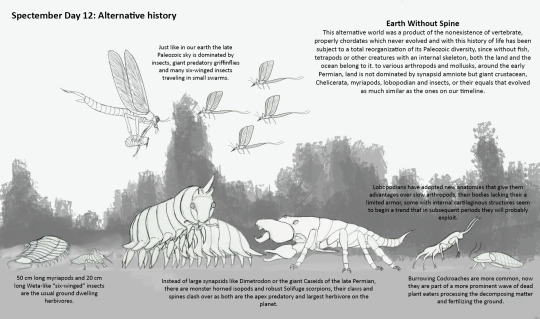
The early Permian of this alternative timeline physically looks almost the same, same geography, same flora, same events of mass extinction, but there is a considerable difference that is remarkable when one checks on the fauna, there are arthropods wandering around, of different sizes, of different shapes, alongside them there are other strange velvet worm like forms, some large mollusks, but what we could recognize nowhere to be found; in the rivers, there are more arthropods and mollusks, and even some large worms, but not bony fishes, sharks or anything that resemble a vertebrate, this world have never seen vertebrates ever.
Something happened through the beginning of the Paleozoic that caused to vertebrates to never evolve, leaving a gap in history that only other animals would fill on their ways.
Moving towards the Silurian and Devonian started to show the consequences of this change as without any type of fish, shark, placoderm, anything that we could relate to the the early paleozoic vertebrate diversification did not happen and the result of such vacuum was the diversity of arthropods and mollusks, some larger species of marine arthropods/panarthropods evolved, some larger mollusks did evolve too, cephalopods and gastropods became predominant where large marine vertebrates should dominate, and in the coasts the trend of arthropod conquest was ongoing as on our world, evolving convergently things like insects, myriapods and arachnids, alongside many other terrestrial crustacean species.
The carboniferous had a different face on land now that since there were not tetrapods taking over and with arthropods like insects and arachnids evolving similarly to our world species, they were fully conquering the planet with diverse and large sized forms, from the early carboniferous to the cooler late period, insects were dominant in numbers on land and the sky, myriapods were the usual predominant herbivores, and arachnids took over predatory roles, being scorpions the apex predators, secondarily were with them some isopod like forms, more packed and suited for dry land so they could extend off the humid forest regions, as well velvet worms which started to be more prominent in some minor parts of the ecosystem.
Up to the early Permian with the desertification of the landscape and loss of environment have pushed the most adaptable species on changing to face the new life conditions, many of the gigantic forms remained, new ecological trends started to appear within some groups, and so this spineless version of the Permian is full of a new cast of arthropods.
The north america of the Early Permian is a land dominated by 50 cm long Solifuge-like scorpions that have evolved with robust chelicerae, more used to large prey they are the apex predators on land, meanwhile in the sky 40 cm of wingspan robust griffin fly predators have evolved, more heavier lethal than any other odonatan, herbivorous palaeodictyopterans still swarm around as well; on the ground is different types of omnivorous and herbivores arthropods going along, there are Arthropleura-like myriapods, but along them some other arthropod herbivores have developed more chubby and taller, these isopod-like armored forms are as big as 1 m, they are close or even heavier than any of the flat Myriapoda; smaller herbivores surround them along, such as 20 cm long flightless cockroaches and Weta-like Palaeodictyopterans are common small herbivores; lobopodians grew up to 30 cm in length, gracile and are among the most agile terrestrial animals on land, sort of evolving a complex inner cartilage skeleton, might become the blueprint of a new future group that will take over in the next periods.
#speculative evolution#alternative evolution#arthropod#paleozoic#permian#insects#myriapods#velvet worm#lobopodia#arachnids
106 notes
·
View notes
Text
Round 2 - Chordata - Actinistia


(Sources - 1, 2)
The Sarcopterygians (“Lobe-finned Fishes”), are the last of the three groups of “fish”, and are so named for the prominent muscular limb buds (lobes) within their fins. Of the Sarcopterygians living today, they are represented by the coelacanths, lungfish, and tetrapods (including humans), who all diverged in the Silurian. These next fish are closer related to us than they are to Actinopterygiians.
The class Actinistia, the “Coelacanths”, are an ancient group of fish that have been around since the Devonian but today are only represented by two remaining species: The West Indian Ocean Coelacanth (Latimeria chalumnae) and the Indonesian Coelacanth (Latimeria menadoensis).
Coelacanths can live as deep as 700 m (2,300 ft) below the sea, but are more commonly found at depths of 90 to 200 m (300 to 660 ft). They have sensitive eyes which include a tapetum lucidum and many rods which help them see better in dark water, as they are most active at night. They are opportunistic hunters, feeding on cuttlefish, squid, snipe eels, small sharks, and other fish found around their deep reef and volcanic slope habitats. Their abundance of fins allow for high maneuverability, and coelacanths can orient their body in almost any direction in the water. They have been seen doing headstands as well as swimming belly up. They are able to slow their metabolisms at will, sinking into less-inhabited depths and going into a hibernation mode to conserve energy.
Coelacanths are ovoviviparous, with the female retaining the fertilized eggs within her body while the embryos develop over a gestation period of five years. The female will give live birth to around 5-26 young. Young coelacanths resemble the adult, but carry an external yolk sac below their pelvic fins, and have larger eyes relative to body size. Individual coelacanths may live as long as 80 to 100 years.
Coelacanths get their name from Coelacanthus, a genus of Permian coelacanths and the first coelacanths to be described. Over 100 fossil species are known, and all of them were believed to have gone extinct in the Cretaceous. On December 23, 1938, the first Latimeria specimen was discovered among the catch of a South African fisherman, making coelacanths a “lazarus taxon.” While previously considered a “living fossil”, coelacanth body shapes were much more diverse in the Early Triassic, and Latimeria is not known from fossils, showing that it had to have gone through some changes to adapt to the modern day.

Propaganda under the cut:
Since there are only two living species in this class and both are threatened, this is the most endangered class of animals in the world.
Coelacanths get along with other coelacanths, though they recoil from physical touch. Scientists think that they recognize each other via electric communication.
Mawsonia was one of the largest known coelacanths, with one specimen estimated at over 5 m (16 ft) long. It lived from the Late Jurassic to Mid-Cretaceous.
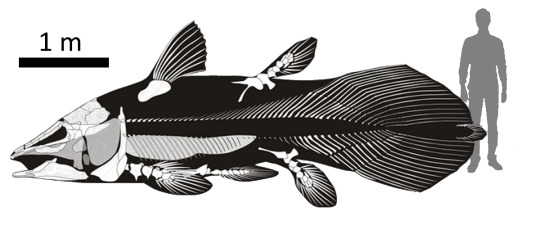
(source)
90 notes
·
View notes
Text
A clown banished for messing up his role in Cats wasn't on my list of possible causes of the Late Devonian Extinction, but maybe it should've been
youtube
135 notes
·
View notes